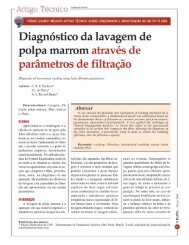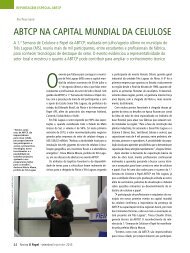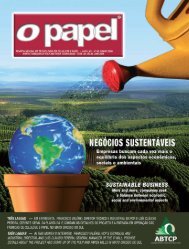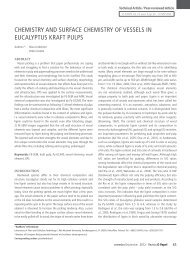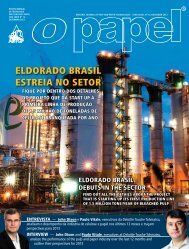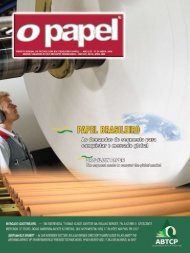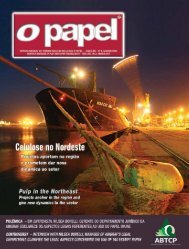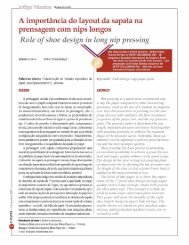international article - Revista O Papel
international article - Revista O Papel
international article - Revista O Papel
You also want an ePaper? Increase the reach of your titles
YUMPU automatically turns print PDFs into web optimized ePapers that Google loves.
• O valor de c é constante no processo<br />
• As energias cinética e potencial (E k<br />
e E p<br />
) são consideradas<br />
desprezíveis<br />
• Uma vez que as perdas térmicas se devem, em sua<br />
maioria, a perdas convectivas ao ar circundante, a<br />
condução através do aço é desprezada, bem como a<br />
convecção internamente à maquinaria.<br />
Sabe-se que:<br />
U = m ⋅ c T (kJ) Equação 12<br />
p<br />
⋅<br />
m = permanência da massa dentro do sistema, o que<br />
compreende a água, peças metálicas e fibras (kg)<br />
c p<br />
= calor específico com pressão constante (kJ/kgK)<br />
T = temperatura do sistema (K)<br />
Aplicando-se a hipótese, pode-se escrever:<br />
(kW) Equação 13<br />
= coeficiente de convecção global, inclusive a área<br />
superficial de convecção (kJ/Ks)<br />
T ∞<br />
= temperature circundante (K)<br />
Designando como H in<br />
a entalpia no início do volume de<br />
controle e H out<br />
a entalpia de saída, o modelo geral do balanço<br />
energético passa a ser:<br />
• The value of c is constant in the process<br />
• The kinetic and potential energies (E k<br />
and<br />
E p<br />
) are considered negligible<br />
• As the heat losses are mostly due to convective<br />
losses to the surrounding air, the conduction<br />
through the steel is neglected, as<br />
well as the convection inside the machinery.<br />
It is known that:<br />
U = m ⋅ c T (kJ) Equation 12<br />
p ⋅<br />
m = mass holdup inside the system, which comprehends<br />
the water, metal parts and the fibres (kg)<br />
c p<br />
= specific heat at constant pressure (kJ/kgK)<br />
T = temperature of the system (K)<br />
Applying the hypothesis, we may write:<br />
(kW) Equation 13<br />
= overall convection coefficient including<br />
the surface area of convection (kJ/Ks)<br />
T ∞<br />
= surrounding temperature (K)<br />
Calling H in<br />
the enthalpy at the beginning of the<br />
control volume and H out<br />
the outgoing enthalpy, the<br />
general energy balance model turns into:<br />
Equação 14<br />
Equation 14<br />
O PAPEL vol. 70, num. 10, pp. 41 - 60 OCT 2009<br />
O PAPEL - Outubro 2009<br />
58<br />
O volume de controle em que esta equação é aplicada<br />
compreende o misturador, a bomba de massa e o refinador<br />
(Figura 2).<br />
Para um fluido incompressível sabe-se que:<br />
Equação 15<br />
sendo v o volume específico do fluido (10 -3 m³/kg) e P out<br />
e<br />
P in<br />
a pressão de saída e a pressão de entrada, respectivamente,<br />
enquanto U in<br />
e U out<br />
são as energias internas de entrada e de<br />
saída. T in<br />
é a temperatura no início do volume de controle<br />
para cada ciclo de refinação e T é a temperatura do fluido<br />
internamente ao volume de controle, que é considerado<br />
constante para cada ciclo.<br />
A temperatura inicial do fluido T in<br />
foi aproximadamente<br />
a mesma que a temperatura circundante T ∞<br />
. Portanto, podese<br />
considerar T in<br />
como constante no início do ensaio. Ao ser<br />
iniciado o processo, a temperatura T in<br />
apresentará aproximadamente<br />
o mesmo valor da temperatura internamente ao<br />
refinador T. Então é razoável desprezar a fração na<br />
Equação 15.<br />
Como o termo na Equação 15 apresenta um<br />
The control volume where this equation is applied<br />
comprehends the mixer, the stock pump and<br />
the refiner (Figure 2).<br />
For an incompressible fluid it is known that:<br />
Equation 15<br />
where v is the specific volume of the fluid (10 -3<br />
m³/kg), P out<br />
and P in<br />
are the outlet and inlet pressure,<br />
respectively, whereas U in<br />
and U out<br />
are the inlet and<br />
outlet internal energies. T in<br />
is the temperature at the<br />
beginning of the control volume for each refining<br />
cycle and T is fluid temperature inside the control<br />
volume, which is considered constant for each cycle.<br />
The initial fluid temperature T in<br />
was about the<br />
same as the surrounding temperature T ∞<br />
. Hence we<br />
can consider T in<br />
constant at the beginning of the<br />
trial. As the process is started, the temperature T in<br />
will have nearly the same value of the temperature<br />
inside the refiner T. Then it is reasonable to neglect<br />
the fraction in Equation 15.<br />
As the term in Equation 15 has a small



